Serviços Personalizados
Artigo
Indicadores
Links relacionados
-
 Citado por Google
Citado por Google -
 Similares em Google
Similares em Google
Compartilhar
Stellenbosch Papers in Linguistics Plus (SPiL Plus)
versão On-line ISSN 2224-3380
versão impressa ISSN 1726-541X
SPiL plus (Online) vol.62 Stellenbosch 2022
http://dx.doi.org/10.5774/62-0-892
ARTICLES
Revisiting Basaa verbal derivation
Emmanuel-Moselly Makasso
National Centre for Education - MINRESI, Yaounde. E-mail: makasso2@gmail.com
ABSTRACT
Basaa, a Narrow Bantu language (A43) spoken in Cameroon in Central Africa holds a serious record of descriptive works in phonology, morphology, and syntax. Verb morphology has been studied in detail by Bitjaa Kody (1990), Dimmendaal (1988), and Hyman (2003), among others. The present paper focuses on verb derivation in Baasa, and raises two main issues: (i) the paradigm of expansions that are recurrent in the language, and (ii) extensions which suggest the existence of additional suffixes to what is already reported. Further extensions include the perfective, the associative, and the tentive. This paper concludes with an attempt to reconstruct Basaa extensions, mirroring Schadeberg's (2003) Proto-Bantu propositions.
Keywords: Basaa; morphological expansion; perfective; associative; tentive
1. Introduction
The aim of this paper is to demonstrate how verbs are constructed in Basaa (6àsàá), a Narrow Bantu language (A43) spoken in Cameroon. Verbal derivatives have been examined in previous studies, e.g., Bitjaa Kody (1990), Dimmendaal (1988), Hyman (2000, 2003), and Voorhoeve (1980), among others.
Basaa verb stems, as in many other Bantu languages, are a combination of the lexical root and one or two extensions. The structure of the verbal stem is thus: [RADICAL - (EXPANSION) -EXTENSIVE SUFFIX]. The final vowel has dropped out in most words in this language. Two aspects of Baasa verb morphology are studied here: morphological expansion and extensions.
The structure of the paper is as follows: in section 2, an overview of Baasa phonology is presented. Section 3 is devoted to morphological expansion, and section 4 to extensions.1
2. Overview of phonology
Basaa phonology is complex enough, with several rules which take the verb stems some time to respect cyclicity given a sound internal hierarchy, without neglecting the templatic and largely concatenative nature of the morphology (Hyman 2000, 2007). The following rules and processes have been accounted for in Basaa: Vowel Height Harmony (section 2.1), toneless suffixes (section 2.2), syncope (section 2.3), and phonotactics (section 2.4).
2.1 Vowel Height Harmony
This process appears only in verbal forms in the context of extension. As Schmidt (1994), followed by Mutaka and Bitjaa Kody (2000), and Sandy (2012) for Abo (A42), point out, Vowel Height Harmony (hereafter VHH) is a process by which the vowel of the verbal stem changes its aperture to a higher level, triggered by the extensive suffix that is added to it. It is important to note that not all the extensions are involved in this process.

2.2 Toneless suffixes
Apart from the stative suffix, which bears a H(igh) /- í/, all the remaining suffixes are toneless. They connect in three phases to the verbal root:
i. They connect to the root and take a default L(ow);
ii. High tone spreading (HTS) when the root is H;
iii. HTS is blocked when as a result of derivation; there are then two consonants in a row following the root.

2.3 Syncope
Work by Hyman (2000) reveals an active process taking place in Basaa, by which the second vowel in a (C)VCVCV sequence is deleted. Due to the vowel deletion process (V.C1V.C2V -> VC1.C2V), two consonants become adjacent across syllable boundaries.

2.4 Phonotactics
When the habitual suffix /-a/ is added to a CVC root, syllabification into a CV.CV structure takes place. Basaa does not admit vowel clusters such as diphthongs. The language tolerates long vowels, but not two different vowels in a row. One strategy to repair ill-formed sequences is to introduce glides.

3. Formal expansion
In some cases, expansions may be identical to extensive suffixes, but the difference lies in the fact that the preceding syllable either has no lexical meaning or has lost it. This phenomenon is referred to in the literature as a "cranberry morpheme". Basaa displays four different expansions: #ra, #le, #la, and #re.

When drawing a semantic generalisation of the stems presented above, one can see the general theme of unsteadiness. These stems are all action predicates.

No semantic generalisation can be made of the stems presented above in (6). These are concrete as well as abstract predicates.

No semantic generalisation can be made of the stems presented in (7), as with the case of expansions with #le.

4. Verbal extensions
This section on verbal extensions goes a little beyond the work on verbal morphology presented in Hyman (2003) and Bitjaa Kody (1990). The following extensions will be discussed:
applicative, causative, reflexive, passive, perfective, habitual, stative, reciprocal, reversive, concomitant, tentive2, and antipassive.
4.1 Applicative
The applicative extension involves the action of being applied on behalf of, towards, or with regard to some object (Lodhi 2002). In the perspective of semantic roles, applicative verbs are expected to play the roles of beneficiary, place, time, cause, reason, and instrument.
4.1.1 Beneficiary
The beneficiary role is the most productive. The forms of the beneficiary are the following, depending on the form of the root:

From the stems presented in (9) above, it is evident that all are monosyllabic, and VHH applies as a rule. But there is an exception with two verbs, presented in (10), that do not apply VHH per se. There is no phonological explanation for the behaviour of these vowels.

The case is different when we move to disyllabic stems, where the suffix form is /-ne/ for open final syllables.

The data in (11) above display an application of syncope. When the stem is VCV, CVCV, or CVVCV and its final vowel is /a/, the suffix for the beneficiary will be /-na/ rather than /-ne/, as illustrated in (12).

However, there are some exceptions, presented in (13), with certain stems failing to apply the rule for reasons that are unclear.

The third category of stem is CVCVC. It forms the beneficiary through the association of /-e/ to the root, as is evident in the data presented in (14).

There are two monosyllabic verbs that behave like CVCVC:

We can then have a sentence like:

4.1.2 Place, time, cause, and reason
The applicative stems in the categories of place, time, cause, and reason behave phonologically like the beneficiary that we have seen above. The table presented in section 4.1.1, repeated here, is applicable to these stems.

4.1.3 Applicative as instrument
There are two forms to express the instrumental meaning of the applicative, namely /-na/ and /-Vl/. Unlike the other applicative structures specified above, the instrumental suffix /-na/ does not absolutely require the verb root to be disyllabic and end in /-a/. There is no phonological context to sketch the distribution of one form or the other.

4.2 Causative
This extension expresses "cause to do" or "cause to be" (Lodhi 2002). In Basaa, there are two ways to express the causative: direct causative, on the one hand, is when the agent acts directly on the patient and obtains a change over his/her being or doing; indirect causative, on the other hand, is when the agent gets the patient him-/herself to change his/her doing or being.
As concerns the direct causative, the form is /-Vs/ ~ /-Vh/. The vowel of the suffix is a copy of that of the root, which is under the VHH constraint. One also has to consider that, in Basaa, there is free variation between [s] and [h] in utterance-final position (Makasso and Lee 2015).

The form of the indirect causative is /-ha/. Just like the direct causative, the vowel of the verbal root will undergo the VHH constraint.

From the data above, we can see that in a VC-HV context, the [H] will metathesize and move to the coda position of the preceding syllable to become VH-CV.
Additionally, it is important to note that the same verb can take the direct causative extension and the indirect causative suffix, resulting in different meanings. As an example, the verb [kòn] 'to be sick' can refer in the direct causative to someone making another sick by doing something to the latter, like feeding or beating. Likewise, the indirect causative meaning denotes someone getting sick but not from the direct action of another.

4.3 Reflexive
The reflexive extension, which is highly productive in Basaa, entails three different nuances, presented as follows:

The first group of verbs, illustrated in (22) below, are intransitive, showing an action, whether physical or psychological, that a person executes on him-/herself.

Concerning the group of verbs showing a change of state, the reflexive suffix brings across the nuance of "becoming". The process of derivation in this specific case is diversified with nominal (23a) as well as adjectival deverbatives (23b).

The third and last category implies that the action one is directing toward oneself is carried out with the help of someone or something. Unlike the two preceding categories, the verbs here are transitive. The suffix used here is -6a.

As we can see from the data presented in above (24), the bilabial implosive /6/ changes to the fricative /ß/ when immediately following a vowel. It may happen sometimes that the same verb gathers both categories of reflexive, resulting in two different meanings. That is the case with tèrj 'to attach / to tie', which can be derived into tèn-èφ or tèn-bà.

Furthermore, the reflexive suffix does not attach to stems with VCVC, CVCVC, or more such combinations. Therefore, to express the reflexive with long verbs, Basaa uses the pronoun /-mere/ '-self3 combined with the passive.

4.4 Passive
The passive form, in its cross-language definition, involves an agent acting upon a subject. That is, the agent in the subject position and the patient/theme in the object position exchange their positions. Basaa displays two suffixes for the passive, namely /-a / (VHH), presented in (27b), and /-ba / (VHH), in (27a). /-ba/ occurs when the verb ends in an open syllable.
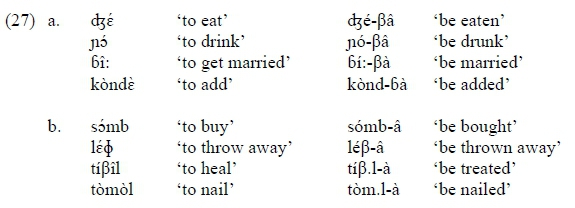
4.5 Positional (stative)
The positional or stative extension (Posit) implies that the subject is, at that moment, tied with a certain position or posture, and that position is likely to be durational (Lodhi 2002). This extension concerns only positional verbs. The suffix for the positional is /-í/ (VHH). VHH here is not automatic and does not concern disyllabic roots. When the verb root ends with an open syllable, there is an epenthetic /-l-/ that prevents two vowels becoming adjacent.
Another distinguishing trait of this extension is that it involves no additional inflectional preverbal morpheme (TAM). Unlike other extensions that involve inflection, the positional already holds the inflection. The suffix /-í/ attaches directly to the root and it appears only on disyllabic verb stems.
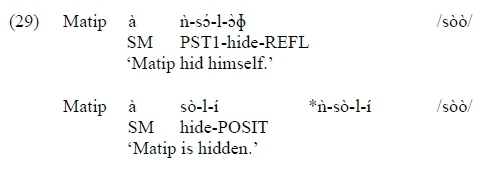
4.6 Perfective
To my knowledge, no previous studies on Basaa mention the perfective extension at all. We have realised that Basaa has a form to indicate that an action has been carried out to completion. The suffix for this extension is /-i/ (VHH). The perfective suffix is toneless, while the stative is H. Furthermore, due to the difference in the inherent aspect of verbs for both categories, the verbs that take a stative suffix cannot take a perfective suffix. VHH does not apply to disyllabic verbal roots and, as one would expect, verbs with perfective extensions are intransitive. Consider the following examples:

4.7 Habitual
The habitual extension demonstrates a tendency or practice that is settled or regular, by which someone is recognised (Lodhi 2002). The meaning is something like "she used to Verbs with the habitual extension can be transitivized or not. The form to mark habitual is /-a/, or /-na/ for vowel-final roots. In the case of long verb roots like CV:CV or CVCCV, the /-a/ of the suffix overrides the final vowel of the root.
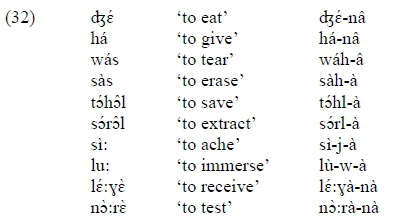

4.8 Reversive
The reversive extension is meant to reverse the meaning of the root onto its semantic opposite. This extension is not highly productive and it gives way to transitive stems. The form is /-Vl/ (VHH), the same as that of the applicative. The vowel of the suffix will be a copy of that of the root, provided that it has undergone VHH.
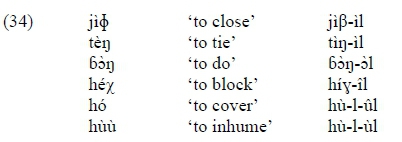
4.9 Associative
This form indicates that the action is reciprocated or done "to one another". This extension, also referred to as the "reciprocal" (Ashton 1944), implies a plural subject (as from two subjects). The form that marks the associative is the suffix /-na/. When we have a long verb root like CV:CV or VCCV, the /-a/ of the suffix overrides the final vowel of the verbal stem. In (35) below, the forms in the column to the right denote "to [verb] each other".

It is important to note that, along with the associative meaning "[verb] to one another", there is another sense of reciprocity among or between entities. The idea here is that of sharing.

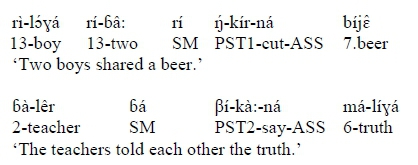
4.10 Concomitant/contemporaneous
The concomitant extension is highly productive in Basaa and involves the action being predicated by the verb and occurring at the same time as a similar event by another agent, e.g., "the train arrives at the same time as the bus". The form of the concomitant is the post-radical suffix /-ha/ (VHH) - the same reflex as for the indirect causative.

As with the associative, the concomitant/contemporaneous extension is only relevant when the subject is plural. Since the /-ha/ cognate is also used for the causative, a singular subject will automatically attract a causative meaning

4.11 Tentive
The tentive extension has not been accounted for in previous work on Basaa. The tentive (Schadeberg 2003), also referred to as the "contactive" (Meeussen 1967), involves the verbal stem containing semantic elements denoting actively making contact. In Basaa, there are two types of contact expressed through morphological means: psychological contact and physical contact. The form for psychological contact is /-ra/, while the form for physical contact is /- be/.


The second category of stems refers to physical contact, implying geographical proximity between two entities. Some of the verbs are transitive correlates of the reversive category, which is intransitive. The distinguishing trait of this extension is that the meaning denotes contact.

There are also tentive extensions on verbs, which are not related to reversive extensions.

4.12 Antipassive
In this section, I explore some data which show that the antipassive extension is at play in Baasa. According to Dixon (1994: 146), cited in Bostoen, Dom and Segerer (2015), a voice construction must meet the following four conditions to be considered antipassive:
(i) It must be a detransitivized construction;
(ii) The subj ect of the antipassive must correspond to the subj ect of the underlying active clause;
(iii) The object of the base verb must either fulfil an oblique function, being treated as a non-core argument, or be omitted;
(iv) There must be some overt formal marking, signalling an antipassive derivation.
In Basaa, the antipassive is expressed by the morphemes /-nà/ and /-à/, and this is evident with only two verbs, namely tëhê 'to see' and nun 'to look'.

From the example above, we can see that tëh-ná in (42a) expresses an associative meaning -the children looked at and saw each other. However, in (42b), the reading is not the same. Used in the singular, the idea of "having the capacity to see" is expressed, not the associative. Used in the plural, the sentence is ambiguous, as it can have both an associative and antipassive meaning. The case is almost similar with (42c), where the sentence expresses the idea of "having one's eyes open".
5. Summary and discussion
To sum up, the various extensions are presented in the following table:

An attempt to reconstruct the Basaa verb extensions leads to the conclusion that the reflexes, except the stative, in this language are somewhat close to the sounds suggested for both Proto-Bantu (Schadeberg 2003) and for Proto-Niger-Congo (Voeltz 1977), as presented in Hyman (2007):

A suggestion for future research, may be to analyse the interaction of phonological, morphological, and lexical information to make Grammar.
References
Ashton, E.O. 1944. Swahili grammar (including intonation). London: Longman. [ Links ]
Bitjaa Kody, Z.D. 1990. Le Système Verbal du Basaa. Unpublished doctoral dissertation, University of Yaounde. [ Links ]
Bostoen, K., S. Dom and G. Segerer. 2015. The antipassive in Bantu. Linguistics 53(4): 731-772. https://doi.org/10.1515/ling-2015-0016 [ Links ]
Dimmendaal, G.J. 1988. Aspects du basaá. [Translated by L. Bouquiaux.] Paris: Peeters/SELAF. [ Links ]
Dixon, R.M.W. 1994. Ergativity. Cambridge: Cambridge University Press. [ Links ]
Hyman, L. 2000. Cyclicity and templatic morphology in the Basaa verb stem. Paper presented at the Second Round Table in Phonology of the GDR 1954, Bordeaux, 8 June 2000.
Hyman, L. 2003. Basaá (A43). In D. Nurse and G. Phillipson (eds.) The Bantu languages. London: Routledge. pp. 257-282. [ Links ]
Hyman, L. 2007. Niger-Congo verb extensions: Overview and discussion. In D.L. Payne and J. Pena (eds.) Selected proceedings of the 37th Annual Conference on African Linguistics. Somerville, MA: Cascadilla Proceedings Project. pp. 149-163.
Lodhi, A. 2002. Verbal extensions in Bantu: The case of Swahili and Nyamwezi. Asia & Africa No. 2: 4-26.
Makasso, E-M. and S. Lee. 2015. Basaa. Journal of the International Phonetic Association 45(1): 71-79. [ Links ]
Meeussen, A.E. 1967. Bantu grammatical reconstructions. Africana Linguistica 3: 79-121. https://doi.org/10.3406/aflin.1967.873 [ Links ]
Mutaka, N.M. and Z.D. Bitjaa Kody. 2000. Vowel raising in Basaa verbal forms. Journal of West African Languages 28: 11-26. [ Links ]
Sandy, C. 2012, Verb Extensions in Abo (Bantu A42). Paper presented at the 43rd Annual Conference on African Linguistics, New Orleans, 15-17 March 2012.
Schadeberg, T. 2003. Derivation. In D. Nurse and G. Philippson (eds.) The Bantu languages. London: Routledge. pp. 71-89. [ Links ]
Schmidt, D.S. 1994. Phantom consonants in Basaa. Phonology 11: 149-178. https://doi.org/10.1017/s0952675700001871 [ Links ]
Voeltz, E.F.K. 1977. Proto Niger-Congo Verb Extensions. Unpublished doctoral dissertation, University of California, Los Angeles. [ Links ]
Voorhoeve, J. 1980. La dérivation verbale en basaá. In L. Bouquiaux (ed.) L'expansion bantoue, vol. 2. Paris: SELAF. pp. 493-501. [ Links ]
1 In this paper, the IPA phonological transcription format is followed. For those who are familiar with Baasa data, we have the following correspondences (in bold): /p/ or /b/ -> /$/ or /ß/; /t/ or /d/ -> /r/; /k/ or /g/ -> /// or /\/; /y/ -> /j/; /ny/ -> /ji/; /j/ -> /d$/; /c/ -> /tf/; /VV/ -> /V:/.
2 What is reported as imperfective (with the /-Vx/ suffix) in previous works on the language will not be considered as an extension in this work, since this imperfective is inflectional. Examples are: (i) m-à:ngè à yá-kè-n-á/ á 6ól 1-child SM FUT2-go-IMP SM arrive 'After a long walk, the child will reach his destination.' (ii) à m-mál-àx 6é d3è 3SG PST1-finish-IMP NEG eat 'She has not yet finished eating.'
3 The prefix of this pronoun concords with the head noun.
4 In the case of both verbs, the epenthetic /-l-/ may be somewhat lexical. In one case, we have the reversive form hú-l-ül 'to discover' already containing this consonant. For the second case, we have the nominal li-sòl 'the act of hiding', where the epenthetic /-l-/ may have been deleted over time.















